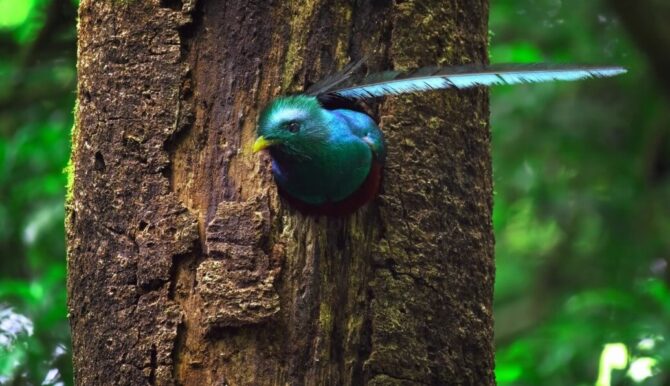Asia is blessed with several species of feathery animals with plumes of bright colors that soar in the skies, perch on buildings, elegantly swim on waters, and gorgeously hop in city squares.
While some of these birds seek solitude within the jungle’s comfort, others do not mind displaying their magnificent feathers wherever humans occupy.
Cranes, pheasants, peafowl, and even eagles are among the most popular species of birds in Asia.
Read on and see which of your favorite birds made it to our list.
Popular & Colorful Asian Birds
10. Large-billed Crow

- Scientific Name: Corvus macrorhynchos
- Length: 1 foot, 6 inches – 1 foot, 11 inches
- Weight: 0.65 kg
- Wingspan: 3 feet, 3 inches – 4 feet, 3 inches
- Where Found: China, Bangladesh, India, Japan, Myanmar, Nepal, Bhutan, Thailand
- Conservation Status: Least Concern
The large-billed crow, one of the jungle crows, is one of the most popular Asian birds and is a widespread Asian bird.
It is characterized by black plumage, with a long bill, thick and arched above; however, it resembles the common raven.
The large-billed crow is one of Asia’s most popular birds due to its adaptability and ability to survive on various food sources, helping to colonize new areas.
These crows eat anything that appears edible, dead or alive, plant or animal. They are also scavengers, ripping open garbage bags and taking wire-made coat hangers to make nests.
The Rara National Park, Nepal, and Bandhavgarh National Park, India, offer sights of the long-billed crow.
Identifying Features: Black plumage; long bill, thick and arched above
9. Channel-billed Cuckoo
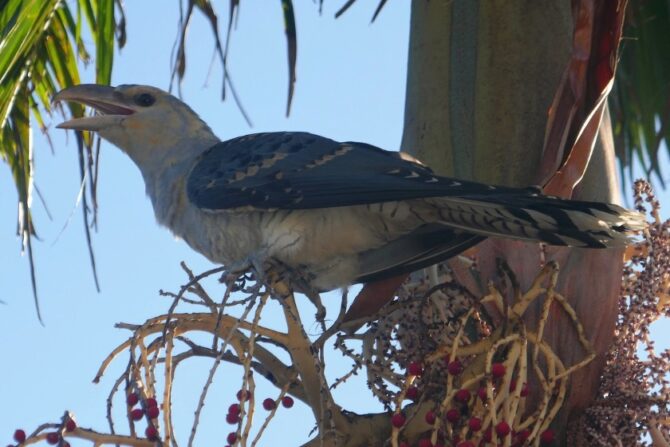
- Scientific name: Scythrops novaehollandiae
- Length: 1 foot, 10 inches – 2 feet, 3 inches
- Weight: 0.56 – 0.935 kg
- Wingspan: 2 feet, 10 inches – 3 feet, 6 inches
- Where Found: Indonesia
- Conservation Status: Least Concern
The channel-billed cuckoo is one of the highest-occurring birds in Indonesia, except during spring when they leave their native Asian range to mate in sub-tropical areas.
The channel-billed cuckoo’s popularity lies in its occurrence and reverence as the world’s largest cuckoo and brood parasite.
While this bird is often shy, one may find them in tree canopies feeding on fruit early in the morning and evening; its loud, raucous sounds might also call one’s attention.
Identifying Features: Slightly curved, bi-colored bill, with a gray base and straw color at the tip; pale gray plumage on the head, chest, belly, and back; dark gray wings with dark tips on the feathers; dark gray tail on top, barred underneath with a black band and white tip; black feet and legs; prominent red skin surrounds the eye.
8. Green Pheasant

- Scientific Name: Phasianus versicolor
- Length: 1 foot, 7 inches – 2 feet, 11 inches
- Weight: 0.7 – 1.4 kg
- Wingspan: 1 foot, 10 inches – 2 feet, 9 inches
- Where Found: Japan, Hawaii
- Conservation Status: Least Concern
Perhaps the green pheasant is more widespread in its native country, Japan, than throughout Asia.
Still, it will be difficult to deny that it is a common species, occurring everywhere, from brushes to grasslands, forest edges, farmlands, parklands, and human settlements.
This Japanese pheasant is found throughout Shikoku, Honshu, Kyushu, and some smaller islands and occurs in Hawaii, where it was introduced.
The green pheasant outcompetes the common pheasant in Japan, making it more common in the country.
Identifying Features: Males – dark green plumage on the breast, neck, mantle, and flanks; bluish-purplish hood with clear ear tufts; red battles; long, pale gray-banded tail; female – brownish-black plumage; dark brown feathers.
7. Garganey

- Scientific Name: Spatula querquedula
- Length: 1 foot, 4 inches
- Weight: 0.24 – 0.58 kg
- Wingspan: 1 foot, 10 inches – 2 feet, 3 inches
- Where Found: Bangladesh, India, Sri Lanka
- Conservation Status: Least concern
The garganey might be a rare breeding bird in the British Isles. Still, it is among the most common wintering ducks in the Indian subcontinent, breeding across temperate Eurasia.
However, the duck is strictly migratory and occurs in the tropics of Southern Africa and even Australasia to earn a “Least Concern” IUCN conservation status.
Loose grey body plumage, scapular feathers, bill, and legs characterize garganeys, but the males are more distinctive due to their brown breast and head with a broad white crescent over the eye.
The Bundala National Park in Sri Lanka is a great destination to watch the migratory duck.
Identifying Features: Brown head and breast; broad white crescent over the eye; grey body plumage, scapular feathers, bill, and legs; reddish brown face; dark crown.
6. Gray Heron
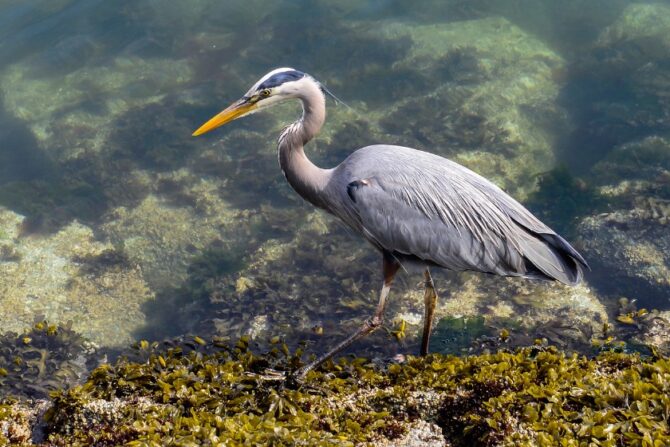
- Scientific Name: Ardea cinerea
- Length: 2 feet, 9 inches – 3 feet, 4 inches
- Weight: 1.02 – 2.08 kg
- Wingspan: 5 feet, 1 inch – 6 feet, 4 inches
- Where Found: Maldives, Singapore, Myanmar, India, Iraq, Iran, Japan, Vietnam, Thailand
- Conservation Status: Least concern
The gray heron is a long-legged bird indigenous to temperate Asia, Europe, and parts of Africa.
In Asia, the gray heron occurs in Maldives, Myanmar, Iraq, India, and Iran, inhabiting their sea coasts, lakes, marshes, rivers, and ponds.
Gray herons occur in the Yala National Park in Sri Lanka and Sungei Buloh Wetland Reserve in Singapore.
As its name suggests, the gray heron is largely covered in gray plumage; however, bluish-black streaks and a straight pinkish-yellow bill also characterize the bird.
Fishes and other aquatic animals constitute the gray heron’s primary diet; little wonder it occupies any suitable waterlogged habitat that can supply its food within its range.
Identifying Features: Ash-gray plumage above; grayish-white plumage below; white head and neck; bluish-black streaks on the neck front; elongated scapular feathers; long, straight pinkish-yellow beak; yellow iris; brown, long legs.
Related: African Birds: 30 Amazing Safari Bird Species, With Pictures
5. Greater Flamingo
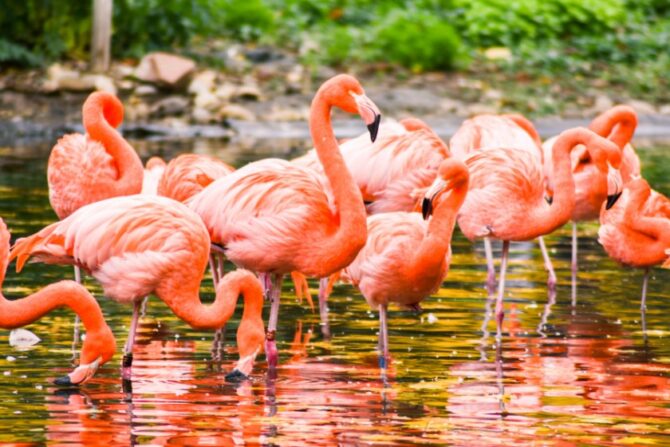
- Scientific Name: Phoenicopterus roseus
- Length: 3 feet, 7 inches – 4 feet, 11 inches
- Weight: 2 – 4 kg
- Wingspan: 4 feet, 7 inches – 5 feet, 5 inches
- Where Found: India, Bangladesh, Bhutan, Maldives, Nepal, Sri Lanka, Pakistan, Iran, Iraq, UAE, Cyprus, Qatar, Kuwait
- Conservation Status: Least Concern
The greater flamingo is the largest living flamingo species; moreover, it is the most widespread flamingo species, occurring in the Indian subcontinent and the Middle East in Asia.
The Khijadiya Bird Sanctuary, Thol Bird Sanctuary, and Flamingo City in India are some wildlife parks to observe the greater flamingo.
The greater flamingo grows between 1 foot, 5 inches, and 1 foot, 11 inches tall and weighs up to four kilograms.
These birds are blessed with pinkish-white plumage, pink bills, and legs.
Identifying Features: Pinkish-white plumage; black primary and secondary flight feathers and red wing coverts; pink bill with a restricted black tip; pink legs.
4. Common Pheasant

- Scientific Name: Phasianus colchicus
- Length: 1 foot, 11 inches or 2 feet, 11 inches
- Weight: 0.5 – 3kg
- Wingspan: 1 foot, 10 inches – 2 feet, 9 inches
- Where Found: Korea, China, Taiwan
- Conservation Status: Least concern
The common pheasant is a well-known gamebird, most likely the most widespread worldwide, but native to Asia.
Sadly, the common pheasant is one of the world’s most hunted birds, but its introduction to many regions and semi-domestication has helped to build sustainable populations.
The common pheasant is a fairly long and chubby bird with a small head, long neck, and tail.
They occur on the sides of country roads, freshly or overgrown harvested fields, hedgerows, and brushy regions. These pheasants occur in Korea, China, and Taiwan.
Identifying Features: Bright gold or fiery copper-red and chestnut-brown plumage; green and purple sheen; white or cream and black-barred markings on the tail; bottle green head with a small crest and distinctive red wattle.
3. Spotted Dove

- Scientific Name: Spilopelia chinensis
- Length: 11 inches – 1 foot
- Weight: 0.16 kg
- Wingspan: 1 foot, 5 inches – 1 foot 7 inches
- Where Found: Sri Lanka, India, Indonesia, China
- Conservation Status: Least Concern
The spotted Dove is native to Asia, across the Indian subcontinent, and in the Southeastern part of the continent.
Residents of Hawaii, southern California, Mauritius, Australia, and New Zealand would not be surprised to find the spotted Dove among the most common birds in their region.
Still, they might be thrown off their feet when they find out that this common species was introduced to those areas.
Spotted doves inhabit most habitats, from scrubs to farmlands, woodlands, and human habitations.
Therefore, one may find them in the Kulu Safaris and Yala National Park in Sri Lanka and Pench National Park in India.
These doves have distinctive rosy buff plumage, with a gray head and belly. However, their name comes from their white tail tips and light buff spots on the wing coverts.
Identifying Features: Rosy buff plumage; gray head and belly; dark brown wing feathers with gray edges; white outer tail feathers.
2. Peregrine Falcon

- Scientific Name: Falco peregrinus
- Length: 1 foot, 1 inch – 1 foot, 10 inches
- Weight: 0.33 – 1.5 kg
- Wingspan: 2 feet, 5 inches – 3 feet, 11 inches
- Where Found: United Arab Emirates, Singapore, Philippines, Taiwan, Japan, Sri Lanka, China, Nepal
- Conservation Status: Least Concern
The peregrine falcon is the world’s most occurring raptor, with an ecological range that spreads across the world, including northern to southern Asia and Indonesia.
It inhabits river valleys, mountain ranges, coastlines, and, crescively, cities. These birds occur in urban areas in most of their range; therefore, they are among Asia’s most-seen birds.
However, one can find them in their natural setting in the Yala National Park in Sri Lanka.
The peregrine falcon has been used for hunting wild animals in their natural habitat for over three millennia, with the practice beginning in Central Asia.
It is revered for its speed, reaching 320 km/h (200 mph) when performing the stoop (soaring highly then diving steeply).
Identifying Features: Bluish black to slate gray back and long pointed wings; black wingtips; white to rusty underparts, with thin clean bands of dark brown or black; long, narrow, and rounded tail; black head and “mustache” along the cheek; white neck; yellow cere and feet; black beak and claws.
1. Peacock (Indian Peafowl)
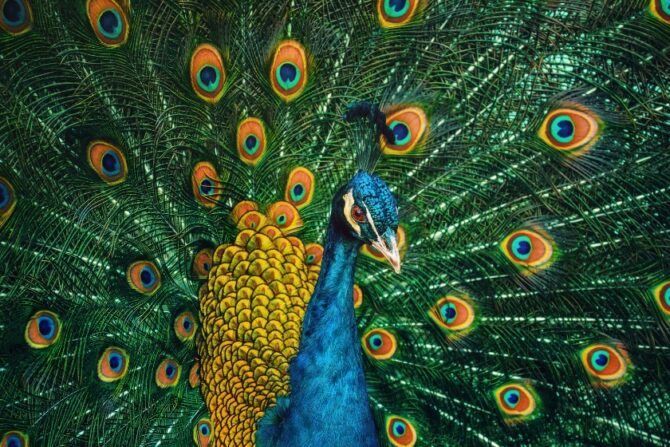
- Scientific Name: Pavo cristatus
- Length: 3 feet, 3 inches – 3 feet, 9 inches
- Weight: 2.7 – 6 kg
- Wingspan: 1.4 – 1.6m
- Where Found: India, Bangladesh, Bhutan, Maldives, Nepal, Sri Lanka, Pakistan
- Conservation Status: Least Concern
The Indian Peafowl is better known as the common peafowl to clear the air whether it exists in India alone or spreads across the continent.
Remarkably, the peafowl is native to the Indian subcontinent, occurring domestically and in the wild across Southeast Asia.
In other parts of the world, the bird exists in captivity or domestically and is a common sight. While poaching of peafowl for their feathers and meat exists, it breeds readily in captivity.
Therefore, parks, zoos, dealers, and bird fanciers maintain stable breeding populations worldwide.
The bird is also culturally protected in many states and by law in India.
Bankura Peacock Sanctuary, Naygaon Mayur Wildlife Sanctuary, and Kasu Brahmananda National Park in India are places to find the peafowl.
Peacocks are more common and entertaining to observe than their female counterparts, thanks to their long train with colorful eyespots.
However, peahens have more intriguing colors owing to their dull brown plumage.
Identifying Features: Blue fan-like crest of spatula-tipped wire-like feathers; a long train of elongated upper-tail covert feathers with colorful eyespots; peahens – white face and iridescent green lower neck; dull brown plumage.
Frequently Asked Questions
How can you attract birds?
You can attract birds as a bird lover by keeping dead trees, putting out nesting boxes, building a brush pile in your yard, offering quality bird feeders, and avoiding pesticides and insecticides.
Which Asian country has the most birds?
Indonesia is revered as the Asian country with the most birds by species count, numbering 1,711 birds. Some notable species in the country include the spotted Dove, channel-billed cuckoo, and peregrine falcon.
Where are some nice destinations to watch birds in Asia?
One might see common Asian birds everywhere, including farmlands and urban areas; however, their beauty might be more appreciated during birdwatching vacations to wildlife parks. The Royal Chitwan National Park in Nepal, Bharatpur Wetlands in India, and Khao Sok National Park in Thailand are wonderful birdwatching destinations.
How can you save birds from extinction?
Some ways to save our colorful, feathery friends from possible extinction include making your windows bird-safe, help reducing climate change, avoiding using chemical fertilizers and pesticides, making your yard a haven for birds, teaching your pets not to go against birds, and donating or involving in a nature conservation group.
Wrap Up
Our colorful feathery friends differ in species; while some might disappear if conservative measures are ignored, others flourish in their abundance, including the ten most common Asian species considered above.
Nevertheless, it is only humane not to allow human activities, climate change, and other environmental challenges to drive these into rarity or force them into extinction.



